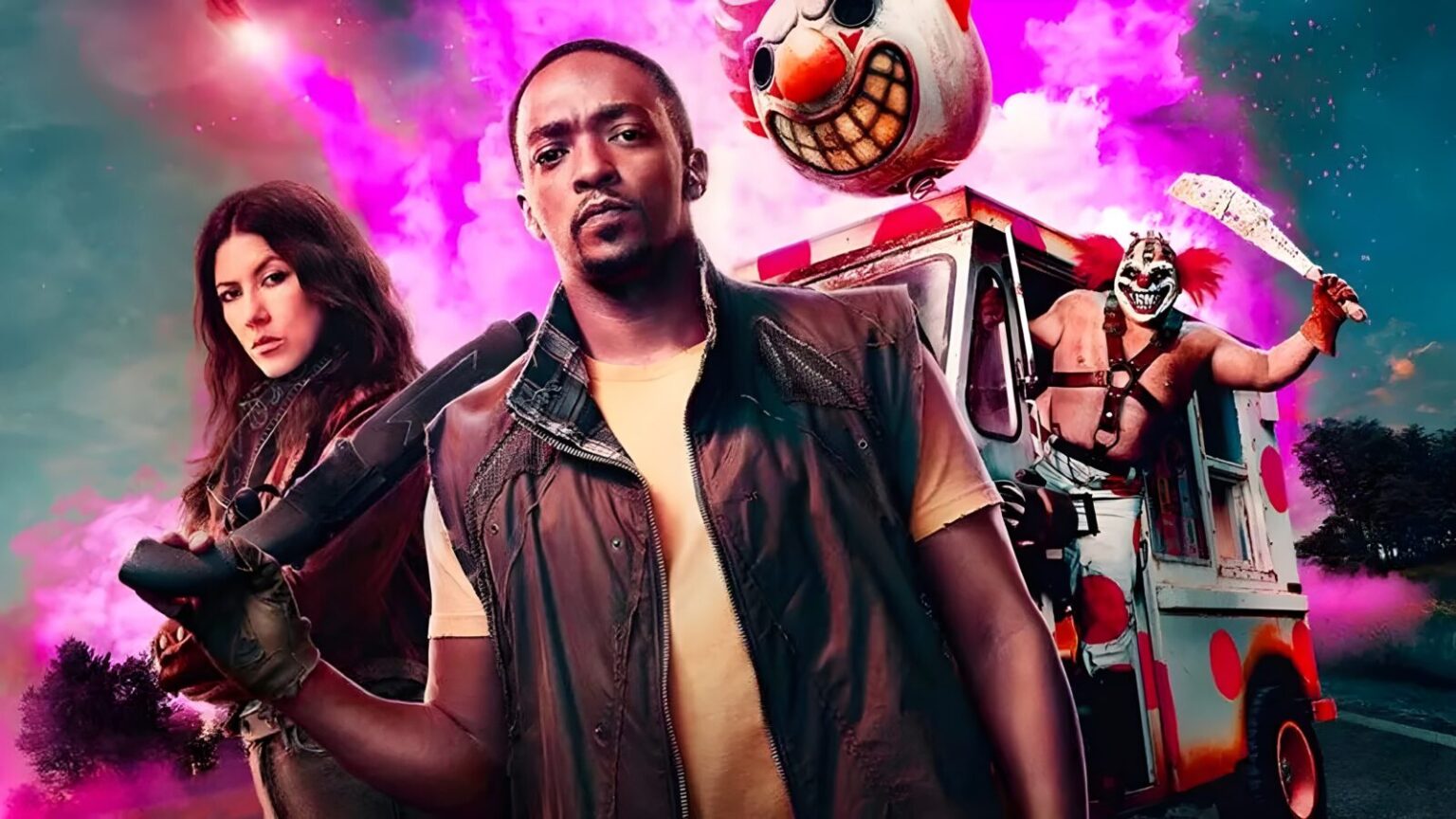TL;DR: Twisted Metal Season 2 takes everything the first season built — the absurdist tone, the vehicular murder ballet, the weirdo-filled apocalypse — and cranks the nitrous until the wheels come off. The result is a louder, bloodier, funnier, and more confidently ridiculous show that finally delivers the tournament fans have been waiting for. It’s still not perfect (some characters are left frustratingly undercooked, and the stakes wobble when death is a suggestion rather than a certainty), but as a love letter to the unhinged, junkyard opera of the games, it’s a twisted joyride worth taking.
Twisted Metal season 2
The Road So Far
When Peacock dropped the first season of Twisted Metal in 2023, I was torn. On one hand, it had everything I wanted on paper: Anthony Mackie cracking wise in a post-apocalyptic wasteland, Stephanie Beatriz delivering deadpan threats between car chases, and a homicidal clown named Sweet Tooth whose default mode was “carnival of nightmares.” On the other hand, the first season felt less like a standalone adventure and more like an extended prologue. It was as if showrunner Michael Jonathan Smith knew we’d have to drive a lot of dusty miles before we hit the real destination.
Well, Season 2 is that destination.
From the first episode, you can feel the difference. The show isn’t just building the world anymore — it’s revving the engine, slamming the pedal, and finally steering us into the carnage-drenched demolition derby that gives the series its name. The Twisted Metal tournament is here, and it’s as gloriously nonsensical as a man welded to two giant tires who drinks gasoline for breakfast.
And yes, that’s a real character.
The Apocalypse Gets a Glow-Up
When I think back to the Twisted Metal games, I remember two things: (1) the vehicular combat was pure chaos, and (2) the character endings were some of the darkest, weirdest little morality plays in video games. Season 2 captures both, but it’s the confidence in the tone that really pops. Where Season 1 sometimes felt like it was afraid to lean all the way into the lunacy, this time the show paints the wasteland in DayGlo blood and lets the freaks run the asylum.
This is immediately clear in the character introductions. The show doesn’t slow-roll the roster like it did last season. Instead, it drops you right into the oil-slick chaos: Vermin, a bug-obsessed exterminator turned road warrior; Mayhem, a mysterious kid tangled up with Dollface’s gang; Mr. Grimm, a soul-eating death biker who may or may not actually be eating souls depending on who you ask; and the aforementioned Axel, a man-machine hybrid that’s the perfect distillation of the franchise’s “why not?” energy.
The production design is having the time of its life here. Every vehicle is a personality on wheels. Vermin’s bug-van is as disgusting as it is inventive, Axel is a walking tank with literal horsepower, and Sweet Tooth’s ice cream truck still looks like it could haunt your dreams. The show leans into practical effects where it can, making crashes and explosions feel tactile in a way that too many modern shows skip for cheaper CG spectacle.
John, Quiet, and the Art of Staying Grounded in a World Gone Mad
Anthony Mackie and Stephanie Beatriz remain the emotional ballast of the show. In lesser hands, John Doe and Quiet could have been cartoon archetypes lost in a cartoon world, but Mackie and Beatriz give them just enough vulnerability and bite to keep them tethered to something human.
This season complicates their dynamic. The will-they-won’t-they of Season 1 has morphed into something less certain and more dangerous. They’re partners in survival first, competitors second, maybe lovers third — and in a world where Calypso promises to grant your heart’s desire, it’s hard not to wonder whether they’d choose each other or their own salvation.
Beatriz in particular thrives when Quiet is surrounded by chaos. Whether she’s trading blows in the arena or trying to untangle her connection to Dollface (played with unnerving charm by Tiana Okoye), she sells the tension between wanting to win and wanting to escape the whole bloody mess.
Sweet Tooth Still Runs the Show (Whether He’s In the Driver’s Seat or Not)
Let’s talk about the homicidal clown in the room.
Joe Seanoa’s physical performance and Will Arnett’s voice work continue to make Sweet Tooth the most magnetic presence in the series. He’s unpredictable in the best way, a mix of Looney Tunes slapstick and Michael Myers-level menace. But what’s new in Season 2 is how the show plays with his relationship to Stu (Mike Mitchell), his long-suffering sidekick.
Stu remains the audience surrogate, the guy looking around at this Mad Max fever dream and going, “Wait, am I the only one who thinks this is insane?” Watching him slowly push back against Sweet Tooth is as funny as it is satisfying. Mitchell nails that tricky balance of cowardice and courage, and his subplot quietly becomes one of the season’s most engaging arcs.
Calypso Arrives, and He’s Perfect
If you know Twisted Metal lore, you know Calypso is the puppet master behind the tournament, a devilish figure who makes deals with desperate drivers and twists their wishes into ironic nightmares. Casting Anthony Carrigan — best known as the endlessly likable NoHo Hank from Barry — seemed, at first, like a left-field choice.
It’s not. It’s genius.
Carrigan’s Calypso is playful and unsettling, a Cheshire Cat with a god complex. He doesn’t just lurk in the shadows; he relishes the chaos. He feels less like a boss battle and more like the game master in a D&D campaign designed to make everyone miserable in the most entertaining way possible. Every scene he’s in becomes instantly more electric.
Where the Show Still Skids Out
For all the improvements, Season 2 still suffers from some of the same issues as its predecessor.
The biggest is depth. While the show does a great job of making the new characters instantly memorable, it rarely lets us live with them long enough to truly care. Mayhem gets intriguing hints of a backstory; Axel feels like he has a whole tragic mythos waiting to be explored. But the show races past these possibilities in favor of another explosive set piece.
Then there’s the problem of stakes. The show isn’t shy about killing nameless goons in spectacularly gory fashion, but when it comes to the main roster, death is often a temporary inconvenience. I get it — nobody wants to throw away a good character too soon — but if the audience starts to feel like there’s always a “continue” button, the tension deflates.
The Verdict
Season 2 of Twisted Metal is the show Season 1 promised it could be. It’s bigger, bloodier, funnier, and more self-assured. It embraces the lunacy of the games without getting lost in it, and it finally delivers the tournament that makes this world tick.
It’s not flawless — some characters deserved more meat on their bones, and the stakes could stand to be sharper — but it’s the kind of sophomore season that justifies the journey. The road to get here was long and occasionally bumpy, but now that we’re in the thick of the madness, I’m happy to keep riding shotgun.





